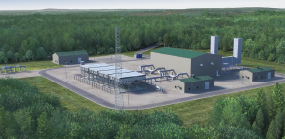Background
Since the last INGAA Foundation midstream infrastructure study completed in 2011,[1] development of North American unconventional natural gas and crude oil supplies, particularly supplies from shale formations, has continued at an unprecedented pace. With the ever-changing supply picture, midstream infrastructure development is crucial for efficient delivery of growing supplies to markets. Sufficient infrastructure goes hand in hand with well-functioning markets. Insufficient infrastructure can constrain market growth and strand supplies, potentially leading to increased price volatility and reduced economic activity.
Natural gas use in North America has increased over the past decade, particularly in the power-generation sector where natural gas has become a fuel of choice. In addition, there has been a resurgence of gas use in industrial applications at the relatively low gas prices that have prevailed during the past few years, while growing production of natural gas liquids (NGL) has stimulated renewed interest in petrochemicals production where ethane and propane are key feedstocks. Meanwhile, growing oil production from unconventional sources has created opportunities for North American refineries to take advantage of crude supplies from various sources.
Midstream infrastructure investments have been keeping pace with supply and market changes. Producers of natural gas, crude oil, and NGL are driving investments in infrastructure by committing to the pipeline capacity needed to ensure delivery of new supplies to markets. Because of these dynamics, the INGAA Foundation felt compelled to update, further refine, and expand its infrastructure study. This new study builds on the prior INGAA Foundation study and considers how the shifting market dynamics
experienced in recent years have altered infrastructure needs and continue to create opportunities and challenges for midstream infrastructure development.
Introduction
The objective of this new study is to inform industry, policymakers, and stakeholders about the new dynamics of North America’s energy markets and the infrastructure that will be needed to ensure that consumers benefit from the abundance of natural gas, crude oil, and NGL across the United States and Canada. This is particularly relevant as policymakers seek to promote job growth and economic development, protect the environment, increase energy security, and reduce the trade deficit.
This study assesses midstream infrastructure needs through 2035 and includes an extensive update of natural gas, NGL, and oil production trends based on projections of drilling activity and consideration of the increasing recoverable resource base and prevailing market conditions.[1] This study expands on the scope of the 2011 study to assess the changing market dynamics and the growing importance of crude oil and NGL production. This study also re-assesses the levels of investment in gas gathering systems; processing plants; gas storage fields; and oil, gas, and NGL transmission lines.[2] It also considers investments that were not considered in the 2011 study, including investments in compression for gas gathering lines, crude oil gathering lines, crude oil storage terminals, NGL fractionation facilities, NGL export facilities, oil and gas lease equipment, and liquefied natural gas (LNG) export facilities. These facilities account for a substantial portion of the total midstream investments identified in this study.
Study results are driven by projected increases in U.S. and Canadian crude oil and natural gas supplies, as well as North American market growth, particularly in the power and industrial sectors. Natural gas imports in the form of LNG, which in previous projections were viewed as a marginal supply source, have been displaced by even more robust domestic gas and NGL production growth, and LNG export capability has been introduced in this updated study. The study projects that NGL use will grow, particularly in petrochemical applications. It also projects new oil supplies will flow to refineries through new or repurposed pipeline infrastructure, displacing foreign imports of oil over time.
Conclusions
The main conclusions in this study are summarized below:
- Significant infrastructure will be needed to support growing gas use. The base case, which assumes $100 per barrel of oil and shows gas prices rising from $4 per MMBtu to an average of $6 per MMBtu in the longer term, and is considered a middle-of-the-road scenario.
- The base case projects significant supply development and growth in gas production, primarily from shale resources. Producers are likely to develop shale plays with large quantities of oil and NGL, which also have significant needs for new pipeline infrastructure.
- The base case projects substantial NGL production growth, especially from the Marcellus and Utica shale plays in the northeastern United States and also from other liquid-rich plays in the United States and Canada. A significant number of gas processing, pipeline, and fractionation facilities are required to accommodate growing NGL production.
§ NGL produced in the northeastern United States from Marcellus and Utica shale seek established petrochemical markets along the Gulf Coast.
§ Alberta oil sands have an increasing need for pentanes-plus NGL to dilute bitumen, aiding the transport of it through oil pipelines.
§ Bakken and Central Rockies NGL flow to the Gulf Coast through West Texas. Flows of raw NGL from West Texas to the Gulf Coast are projected to double by 2035.
§ The base case also projects significant growth of NGL exports from the Gulf Coast and Western Canada.
- The base case projects robust growth of crude oil and condensate production, mostly from Alberta oil sands and tight/shale oil plays, driven by relatively high oil prices. A significant number of pipeline expansions and new pipelines are under development, and incremental transport capability is needed to accommodate growing crude oil and condensate production.
§ Alberta oil sands production is projected to nearly triple by 2035. Bakken shale crude oil production will double by 2020 to almost 1.8 million BPD and increase to 2.1 million BPD by 2035. Significant crude production growth is also expected from West Texas and Gulf Coast tight/shale plays.
§ Exports off of the West Coast of Canada will increase by more than 2 million BPD from 2020 through 2035.
From 2011 through 2035, the following approximate amounts of new infrastructure are required:
Natural gas infrastructure:
§ Approximately 43 Bcfd in new gas transmission capability
§ About 850 miles per year in new gas transmission mainline
§ Over 800 miles per year in new laterals to/from power plants, processing facilities, and storage fields
§ Almost 14,000 miles per year in new gas gathering lines
§ Approximately 35 Bcfd of new gas processing capability
§ About 37 Bcf per year in new working gas storage capacity
§ More than 580,000 horsepower per year for pipeline and gathering compression
§ About 9 Bcfd of new LNG export capacity
NGL infrastructure:
§ About 3.6 MMBPD in new NGL transmission capacity
§ Almost 700 miles per year in new NGL transmission line
§ About 30,000 horsepower per year for pumping requirement for pipeline
§ Approximately 151 MBOE/d in new NGL fractionation capacity is added each year
§ Almost 64 MBOE/d in new NGL export capacity is added each year.
Oil infrastructure:
§ More than 10 MMBPD in new oil transmission capacity
§ Over 730 miles per year in new oil transmission line
§ About 35 miles per year in new laterals for crude oil storage
§ Approximately 7,800 miles per year in new oil gathering lines
§ Over 6 MMBbl per year in new crude oil storage capacity
Expenditures for the incremental infrastructure projected here are significant:
§ More than $640 billion or about $30 billion per year, in total capital expenditures are required over the next 22 years for the combined natural gas and liquids outlook.
§ $10 billion per year, or 34 percent of this amount, is required for new oil and gas lease equipment.
§ Almost $9 billion, or 29 percent, is for new or expanded gas and liquids mainline capacity.
§ More than $3 billion per year, or 11 percent, is needed for new oil and gas gathering lines.
§ More than $2 billion per year, or 8 percent, is required for new laterals.
§ Roughly $2.0 billion per year, or 7 percent, is required for new LNG export facilities.
§ More than $1 billion per year, or 4 percent, is required for new processing plants.
§ Roughly $1.0 billion per year, or 3 percent, is required for new NGL fractionation plants.
§ The remainder, almost $1 billion per year, is for underground gas storage, crude oil storage, and NGL export facilities.
This study includes additional new facilities that were not included in the 2011 study:
§ These facilities include compression for gas gathering lines, crude oil gathering lines, crude oil storage and laterals, NGL fractionation, NGL export facilities, oil and gas lease equipment, and LNG export facilities.
§ These additional facilities account for almost $300 billion, or more than 45 percent of the total expenditure.
Even the low-growth case shows substantial need of new midstream infrastructure:
§ Total midstream expenditures projected in the low-growth case are $465 billion, 27 percent lower than the reference case.
§ Even with lower projected oil prices and lower economic growth in the low-growth case, the expenditures for midstream infrastructure requirements are still very significant.
§ Reductions in expenditures are generally similar on a percentage basis across many of the infrastructure categories.
The economic benefits of midstream infrastructure development are significant:
- Based on IMPLAN analysis, the base case projects that an average of roughly 432,000 jobs will be needed to accomplish the levels of infrastructure development that occur in the case. The development of the infrastructure will yield a value added of roughly $885 billion to the U.S. and Canadian economies, and federal, state/provincial, and local taxes totaling roughly $300 billion.
- As a practical example of this, every $100 million of investment in new infrastructure creates an average of about 67 jobs over the projection period and adds roughly $138 million in value to the U.S. and Canadian economies.
- The low-growth case, while yielding values that are between 20 percent and 30 percent below the base case values, still provides substantial economic benefits to the U.S. and Canadian economies over time.
- While many of the economic benefits accrue directly to companies active in midstream development, there are many indirect and induced benefits that occur in many other industries, and a substantial number of service sector jobs are created as a result of the midstream development.
- Although many of the economic benefits are concentrated in areas where midstream development has been historically prevalent, the benefits are geographically widespread. All sectors and regions of North America benefit from the infrastructure development.



